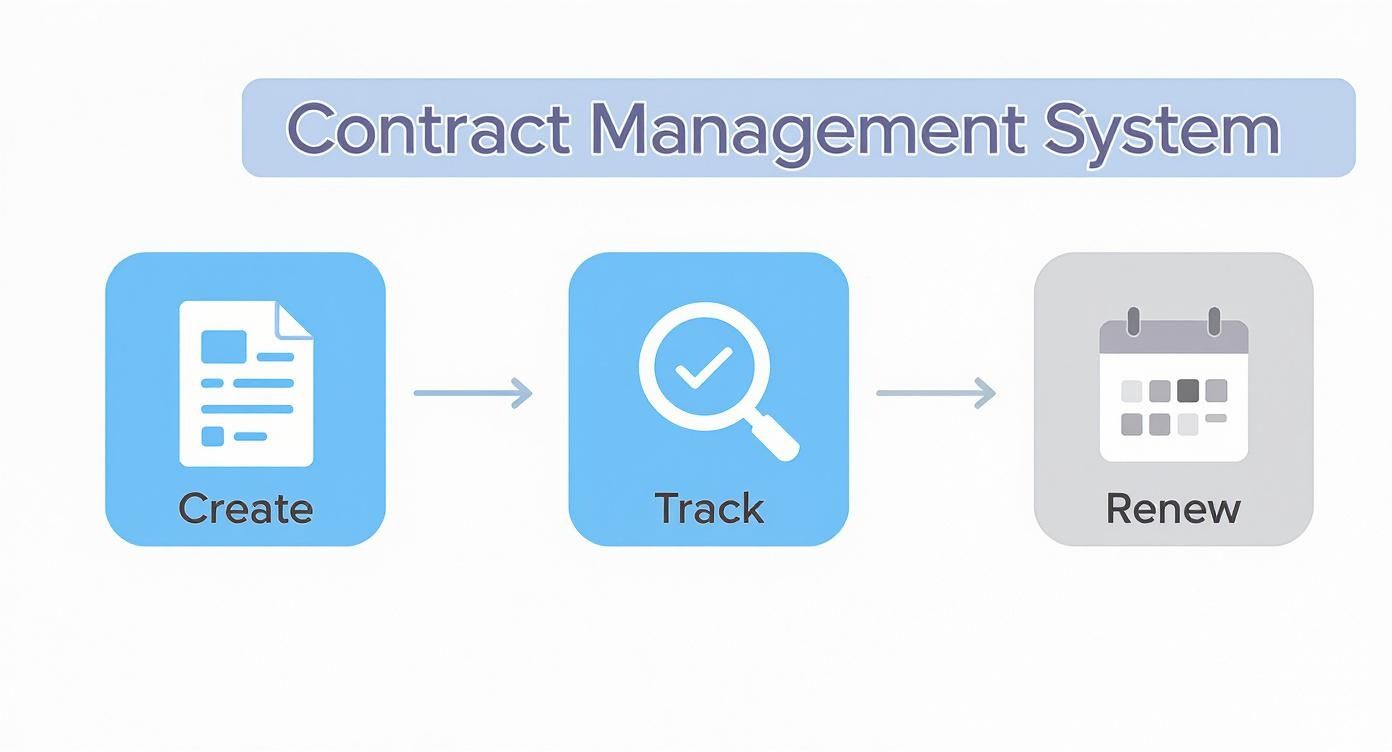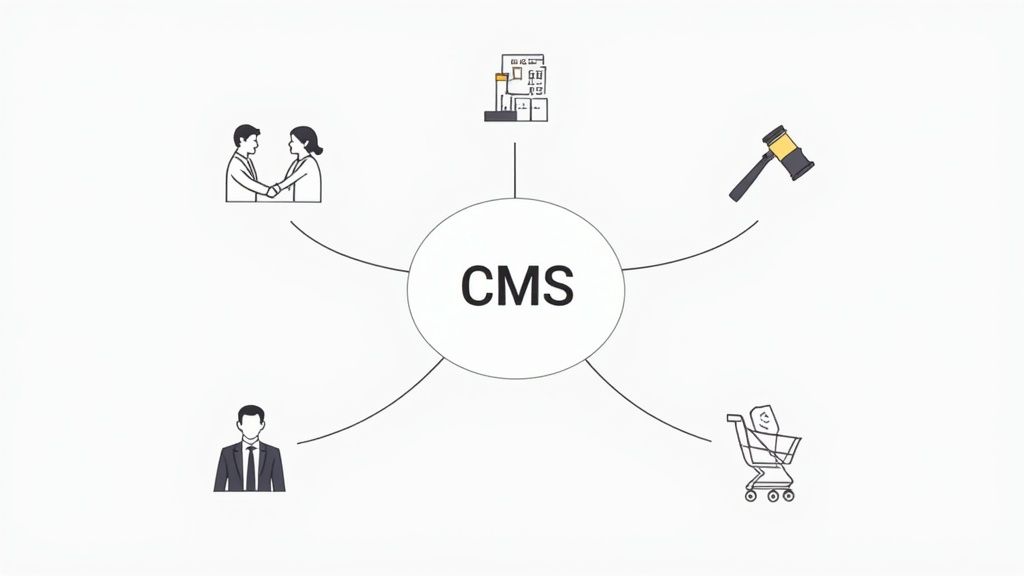
 18 minutes read
18 minutes read
You know that shared server folder labeled "Contracts"? The one that's a bottomless pit of documents with names like MSA_v4_Final_Approved_FINAL.docx? We've all been there, frantically searching for a specific clause with a deadline looming. It’s a special kind of corporate hell.
A contract management system is supposed to be the antidote to that chaos. It's a specialized piece of software built to manage the entire journey of a contract, from the first draft all the way through to renewal or termination. Think of it as a central command center for every legal agreement your business handles, making sure nothing ever gets lost, missed, or forgotten.
Let's cut through the jargon. A contract management system isn't just a glorified Dropbox or a fancier shared drive. That's like calling a race car "a thing with wheels." It’s a dynamic, intelligent hub designed to give you complete visibility and control over all your company's agreements.

Forget digging through endless email threads to find the most recent version of a contract. A proper system acts as your single source of truth, ensuring everyone—from sales to legal—is on the same page. It’s the difference between navigating a storm with a rusty compass and having a full GPS-guided dashboard.
At its heart, this software is all about managing the contract lifecycle. It’s not about passive storage; it's about active, hands-on management from start to finish. While it might feel similar to a case management system you can learn about here, its entire focus is locked onto the unique—and often messy—journey of your agreements.
So, what does that look like day-to-day? It means the system is actively working for you on tasks like:
It effectively transforms a messy, high-stakes administrative burden into a smooth, strategic advantage. The system always knows who signed what, when an agreement expires, and which obligations are on the horizon. It’s less like a filing cabinet and more like a tireless, hyper-organized paralegal who never takes a coffee break.
That color-coded Excel sheet you’re so proud of? It’s costing you money. Big time.
You might think manual tracking is getting the job done, but it’s a silent drain on your company's resources. It all seems fine until a key renewal date slips by, locking you into another year with a vendor you were planning to drop. Or worse, a surprise non-compliance fine lands on your desk because a crucial clause was buried and forgotten.
The $500 Hello.
Think about the real costs of the old way:
It happens more often than you’d think. A motivated salesperson, eager to close a deal, uses an antiquated contract template and gets it signed before the legal team can even review it. Now you're locked into terms that expose the business to unnecessary risk.
Spreadsheets give you the illusion of control, but in reality, they deliver chaos once you're managing more than a handful of agreements. A cell in a spreadsheet can't flag a risky clause, alert you to a looming deadline, or ensure everyone is using the most current, approved language. It's a system with no safety net.
Let's break down the hidden costs of sticking with the old way versus adopting a modern solution.
| Manual vs Automated The Real Cost of Contract Management |
| :— | :— | :— |
| Pain Point | The Spreadsheet 'Solution' | The CMS Reality |
| Missed Renewals | Relying on manual calendar entries and fallible human memory. | Automated alerts give you weeks or months of notice. No excuses. |
| Template Errors | Navigating a maze of "Contract_v3_Final_FINAL.docx" files. | A central, approved clause and template library for everyone. Idiot-proof. |
| Lost Clauses | Wasting hours with Ctrl+F, praying you find what you need. | An instantly searchable repository for every contract you manage. Done in seconds. |
As you can see, what feels "free" upfront with a spreadsheet ends up costing you dearly in errors, wasted time, and missed opportunities.

The difference is stark: manual processes create bottlenecks and risk at every stage, while an automated workflow brings control and clarity to the entire contract lifecycle.
The time wasted on manual methods is staggering. In fact, 73% of companies report significant delays just trying to locate specific contract terms. These aren't just minor inconveniences; they are direct hits to productivity. You can dig deeper into the contract management software market findings to see just how widespread this issue is.

Preventable mistakes tied to contract dates cost businesses an estimated $2.4 billion annually, according to industry analysts. That's a lot of ping-pong tables.
Switching to a Contract Management System (CMS) does more than just organize your files. It actively plugs revenue leaks and cuts down on unforced errors that can have serious financial consequences.
For businesses dealing with compliance, the stakes are even higher. A manual process that overlooks a clause related to GDPR or HIPAA can trigger audits and fines that would make the cost of a CMS look like a rounding error.
A good CMS brings order to the chaos. Automated reminders make critical deadlines visible across teams, from legal to finance, so nothing falls through the cracks. Ever.
True version control means every edit is tracked, creating a clear audit trail. You’ll never again have to worry about the wrong version of an agreement being signed.
Contracts slipping through the cracks isn't an inevitable cost of doing business—it's a clear symptom of using the wrong tools for the job. Upgrading from that chaotic spreadsheet to a dedicated CMS turns a major liability into one of your business's best defense mechanisms for protecting revenue and mitigating risk.

Every software sales page throws a kitchen sink of features at you, promising the world. But let’s be honest, you’re not going to use half of them. I’ve been down this road, and a lot of that is just noise designed to justify a higher price tag.
So, let's cut through the fluff. Here are the core, non-negotiable features you’ll actually use day in and day out—the ones that stop the bleeding and give you back your sanity.
First up, a centralized repository. No, I don't mean another messy shared drive. I'm talking about a smart, searchable database where every single contract lives. If you can’t instantly find an agreement by searching a counterparty name, a specific clause, or even a renewal date, you've just bought a very expensive digital shoebox.
A proper repository gives you a complete, organized view of every agreement. It’s the difference between frantically digging through old emails and having a hyper-organized paralegal who knows exactly where everything is, all the time.
Next, automated alerts and notifications. This one is simple, but it’s an absolute game-changer. Manual calendar reminders are a joke; they’re the first thing to get ignored when things get hectic. You need a system that automatically flags upcoming renewal dates, expirations, and other key milestones—and keeps nagging the right people until they take action.

This isn't just a "nice-to-have." This is the feature that single-handedly stops you from accidentally auto-renewing a five-figure contract with that vendor you’ve been meaning to fire for a year.
Remember Contract_v4_Final_Approved_FINAL.docx? We can leave that nightmare behind. Version control is absolutely essential for any business that's serious about its documents. A good system tracks every single redline, comment, and change, creating a crystal-clear audit trail.
This means you always know who changed what and when. More importantly, it guarantees that the version you send out for signature is the actual final version, not the one from three drafts ago. It’s a simple feature that prevents incredibly costly mistakes.
Finally, let’s talk about the clause and template library. This is your secret weapon against rogue dealmakers and inconsistent agreements. It’s a pre-approved library of standard contract language and complete templates that your entire team can pull from.
Here’s why it’s so critical:
And of course, seamless e-signature integration is a must-have. If your team is still printing, signing, and scanning documents, you’re stuck in the dark ages. The ability to execute contracts with a few clicks is the final piece that ties this whole efficient puzzle together. Anything less is just a bottleneck.

Here’s a hard truth: if your shiny new contract management system doesn't talk to your other software, you’ve just bought another expensive data silo. Congratulations. You've created one more island of information that your teams have to swim between, wasting time and creating confusion.
A real CMS isn't just an administrative tool; it's the central nervous system for your entire business. It should plug directly into the tools your teams already live in, making everyone's job easier, not harder. This isn't about adding another login to everyone's password manager; it's about making critical data flow seamlessly where it's needed most.
Let’s start with the most obvious win: connecting your CMS to your Customer Relationship Management (CRM) platform, like Salesforce. Your sales team lives and breathes in the CRM. Forcing them to jump into another system to generate a contract is like asking them to run a marathon with their shoes tied together. It’s slow, clunky, and they’ll hate you for it.
When your CMS and CRM are integrated, salespeople can:
This is a massive unlock. In fact, the global market for contract management software is set to double to $5.65 billion by 2030, with sales teams leading the charge as the fastest adopters. They know it’s the key to closing deals faster. Learn more about the CMS market growth from Grand View Research.
Next up is your Enterprise Resource Planning (ERP) system. Your finance team needs to know what financial commitments are tied to every single contract. Without an integration, they’re flying blind, manually chasing down details for billing schedules, payment terms, and revenue recognition. It’s a recipe for disaster.

A connected CMS gives finance a crystal-clear, real-time view of every dollar in and every dollar out. No more surprises at the end of the quarter.
When your CMS talks to your ERP, you’re not just managing documents; you’re managing financial outcomes. This level of coordination is a core tenet of effective operations, much like what you'd find when exploring the principles of legal project management. It turns your contract repository from a simple library into a source of powerful business intelligence, creating a unified, accurate view of every customer and vendor relationship.
Alright, you're convinced. You see the spreadsheet for the ticking time bomb it is, and you’re ready to upgrade. Now for the hard part: how do you actually pick a system without sitting through a dozen soul-crushing demos that all blur into one?
Welcome to the no-nonsense buyer's guide. The first rule? Don't start by looking at software. Start by looking at your own mess. Seriously. Map out your current process—the good, the bad, and the embarrassingly inefficient. Where do contracts get stuck? Who is always the bottleneck? What's the one thing that, if fixed, would make everyone's life easier?
Your answers to these questions are your roadmap. Don't let a slick salesperson tell you what your problems are. Define them yourself, first. This initial step is a lot like creating standard operating procedures for any other critical task; you need to understand the workflow before you can effectively improve it. Once you know what’s broken, you’ll be immune to the marketing fluff.
Now, let’s talk features. Every provider will show you a laundry list of capabilities, but you probably only need a fraction of them. Don't pay for bloated enterprise tools designed for a 50-person legal department if you're a team of five.
Get brutally honest about your needs. Create a simple checklist. Is a searchable central repository your top priority? Is it automated alerts for renewals? Maybe it's seamless integration with your CRM. Be specific. This clarity will be your shield against overpaying for features you’ll never touch.
Think of it like this: are you buying a Swiss Army knife when all you really need is a rock-solid screwdriver? Focus on the core job to be done.

The No-Fluff Buyer's Checklist
- Ease of Use: If I can’t figure out the basics in 15 minutes, will my team ever adopt it?
- Implementation Lift: How much work is it to get our existing contracts into this thing? Do they help, or are we on our own?
- Core Problem Solved: Does this directly fix my #1 pain point (e.g., missed renewals, version control chaos)?
- Integration: Does it play nice with the software we already use every single day (CRM, e-signature, etc.)?
- Scalability: Will this system grow with us, or will we be shopping for a new one in two years?
- Support: When something breaks at 5 PM on a Friday, is anyone going to answer the phone?
Finally, never buy without a test drive. But don't just click around during a free trial. Pick a small, real-world project—maybe five to ten active contracts—and run them through the system from start to finish. This is the only way to know if the software works in practice, not just in a demo.
This is your chance to ask the tough questions. You’ll quickly find out if the platform is as intuitive as promised or if it creates more headaches than it solves. Making a confident decision comes from seeing the proof yourself, not just believing a sales pitch.
Let’s pull this all together. Bringing a contract management system into your company isn't just about adding another tool to your tech stack. It's a decision to fundamentally change how you do business—moving from a state of constant reaction to one of proactive control.
Think about the old way of doing things. Juggling contracts manually is like trying to patch a leaky boat with duct tape. It’s a constant, resource-draining battle that slows you down and leaves you wide open to unnecessary risks. A dedicated system lets you stop bailing water and start steering the ship. You’re not just plugging holes; you're building a more resilient, efficient foundation for your business.
This isn’t just a nice idea; it’s where the industry is heading. A staggering 74% of legal departments have already made the switch to a CMS, and many are now using AI to handle reviews and spot potential issues before they become problems. They aren't just buying software; they're buying back time and gaining a serious competitive edge. You can see the data for yourself in these legal tech trend reports.

In the end, this is about giving your contracts the strategic attention they demand. It's about empowering your team to stop chasing paperwork and start focusing on what truly drives your business forward: growth. The choice is clear.
Alright, let's tackle some of the questions probably bouncing around in your head. I've seen these systems from the inside out, so here are the straight answers.
Absolutely not. That’s a common myth, usually peddled by vendors with enterprise-sized price tags. While giant corporations were early adopters, today’s cloud-based systems are built and priced for businesses of all sizes, from scrappy startups to established mid-sized companies.
If you think you're "too small" for a CMS, you're essentially signing up for administrative chaos. If you're handling more than a dozen contracts a month, the inefficiency of manual methods is already costing you. In my experience, smaller companies often see the fastest and biggest ROI because they can build good habits from the start, instead of trying to fix years of ingrained chaos later.
It’s not the multi-year, mortgage-your-ping-pong-table ordeal it used to be. The best modern systems are designed for a quick setup, not a marathon IT project. Honestly, the biggest lift is usually getting your mountain of existing contracts into the new system.
My advice? Look for a provider that offers hands-on support with that migration process. A good rule of thumb: if you can't be up and running with the core features in a week or two, the system is probably too complex for what you actually need.
Great question, because the industry loves its acronyms. Technically, a CMS (Contract Management System) often refers to post-signature activities like storage, tracking, and alerts. A CLM (Contract Lifecycle Management) is the whole enchilada—from initial drafting and negotiation all the way through to renewal or termination.

In reality, the lines have blurred so much that most modern tools are full CLM platforms, even if they call themselves a CMS. My take? Ignore the acronyms and focus on the features. Does it solve your specific pain points? That’s all that matters.
Yes, and this is where it pays for itself. A good system helps enforce compliance in two critical ways. First, by using pre-approved templates and clause libraries, it stops your team from going rogue and using risky, outdated language just to close a deal faster.
Second, it automatically tracks key dates, obligations, and regulatory requirements (like GDPR or HIPAA), sending alerts to the right people so nothing ever falls through the cracks. It turns compliance from a panicked, last-minute scramble into a predictable, automated process.
Ready to stop managing paperwork and start growing your firm? HireParalegals gives you access to a curated network of over 10,000 pre-vetted legal professionals who can manage your contracts, streamline your workflows, and cut your payroll costs by up to 80%. Find your next remote paralegal in as little as 24 hours. Learn more at HireParalegals.